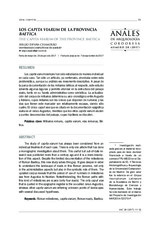Mostrar el registro sencillo del ítem
Los capita viarum de la provincia Baetica
| dc.contributor.author | España Chamorro, Sergio | |
| dc.date.accessioned | 2018-01-22T08:10:18Z | |
| dc.date.available | 2018-01-22T08:10:18Z | |
| dc.date.issued | 2017 | |
| dc.identifier.issn | 1130-9741 | |
| dc.identifier.uri | http://hdl.handle.net/10396/15908 | |
| dc.description.abstract | Los capita viarum siempre han sido estudiados de manera individual en cada caso. Tan sólo un artículo, ya centenario, ahondaba sobre esta problemática, aunque su análisis era meramente descriptivo. A pesar de la parca documentación de los miliarios béticos al respecto, este estudio solventa algunas lagunas y permite ahondar en la estructura del paisaje viario, tanto en su faceta administrativa como simbólica. La actualización del corpus de miliarios determina su arco cronológico entre Augusto y Adriano, cuyos miliarios son los únicos que disponen de numeral, y las vías que tienen este marcador son relativamente escasas, siendo sólo cuatro. El único caput viae que es citado en la documentación epigráfica viaria es el Ianus Augustus, mientras que los otros capita viarum aluden a puntos desconocidos del paisaje, cuyas hipótesis se discuten. | es_ES |
| dc.description.abstract | The study of capita viarum has always been considered from an individual treatment of each case. There is only one article that has done a monographic investigation about them. This useful but out-of-date research was published more than a century ago and it is a mere description of this aspect. Despite the limited documentation of the milestones of Roman Baetica, this new study solves this gap. It goes deeper in order to understand the landscape of roads in this Roman province, not only in the administrative aspects but also in the symbolic role of them. The updated corpus reveals that the period of use of numbers in milestones was from Augustus to Hadrian. Notwithstanding, the Roman paths with this kind of milestones are scarce (only four roads). The only caput viae that is quoted in the epigraphic register is the so-called Ianus Augustus, whereas other capita viarum are referring unknown points of landscapes with several discussed hypotheses. | es_ES |
| dc.format.mimetype | application/pdf | es_ES |
| dc.language.iso | spa | es_ES |
| dc.publisher | Universidad de Córdoba, Área de Arqueología | es_ES |
| dc.rights | https://creativecommons.org/licenses/by/3.0/ | es_ES |
| dc.source | Anales de Arqueología Cordobesa 28, 11-32 (2017) | es_ES |
| dc.subject | Miliarios romano | es_ES |
| dc.subject | Capita viarum | es_ES |
| dc.subject | Vías romanas | es_ES |
| dc.subject | Bética | es_ES |
| dc.subject | Roman milestones | es_ES |
| dc.subject | Roman roads | es_ES |
| dc.subject | Baetica | es_ES |
| dc.title | Los capita viarum de la provincia Baetica | es_ES |
| dc.title.alternative | The capita viarum of the province Baetica | es_ES |
| dc.type | info:eu-repo/semantics/article | es_ES |
| dc.relation.publisherversion | https://www.uco.es/ucopress/ojs/index.php/anarcor/index | es_ES |
| dc.rights.accessRights | info:eu-repo/semantics/openAccess | es_ES |

